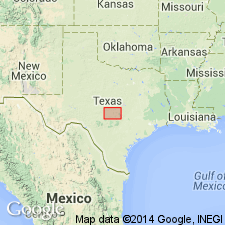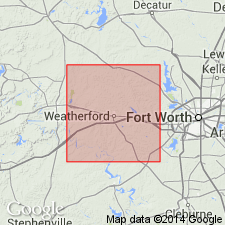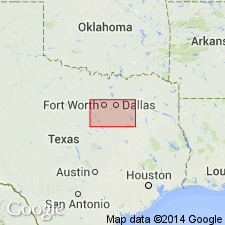
- Usage in publication:
-
- Mingus shale member
- Modifications:
-
- Original reference
- Dominant lithology:
-
- Shale
- AAPG geologic province:
-
- Bend arch
Summary:
Pg. 75, 76, and charts; Jour. Geol., v. 30, p. 25, 31. Mingus shale member of Mineral Wells formation. Gray sandy shale, 250 to 300 feet thick, overlying Thurber coal, which is basal bed of Mineral Wells formation (of Strawn group). The shale is nowhere well exposed in complete section, but is observed in coal mine shafts and well borings. Underlies Brazos River sandstone. Age is Pennsylvanian.
Named from small mining town south of Mineral Wells, Palo Pinto Co., central northern TX.
Source: US geologic names lexicon (USGS Bull. 896, p. 1381).

- Usage in publication:
-
- Mingus shale member*
- Modifications:
-
- Revised
- AAPG geologic province:
-
- Bend arch
Summary:
Pg. 106, 108. Mingus shale member of Garner formation. G. Scott and J.M. Armstrong (ms. on geol. of Parker Co.) restrict Minerals Wells formation to beds above Brazos sandstone member, and introduce Garner formation, to include lower part of Mineral Wells formation, or (descending) Brazos sandstone, Mingus shale, and Thurber coal members. Age is Pennsylvanian.
Source: US geologic names lexicon (USGS Bull. 896, p. 1381).

- Usage in publication:
-
- Mingus shale member
- Modifications:
-
- Revised
- AAPG geologic province:
-
- Fort Worth syncline
Summary:
Pg. 20-21, fig. 3. Mingus shale member of Garner formation. Total thickness (in Parker County, north-central Texas) 210 feet measured in traverse from approximate base of member in bed of Rock Creek to base of Brazos River sandstone member in scarp west of Millsap; base not everywhere exposed. Includes thin coal seam which in this report is not considered to be Thurber coal as described by Plummer and Hornberger, 1936 (Univ. Texas Bull., no. 3534). Overlies Goen limestone bed in Grindstone Creek formation. Age is Middle Pennsylvanian.
Source: US geologic names lexicon (USGS Bull. 1200, p. 2519).

- Usage in publication:
-
- Mingus Formation
- Modifications:
-
- Mapped 1:250k
- Dominant lithology:
-
- Shale
- Sandstone
- AAPG geologic province:
-
- Fort Worth syncline
Summary:
Mingus Formation of Strawn Group. Shale and sandstone. Includes Dobbs Valley Sandstone [unranked] in middle part. Overlapping Cretaceous rocks cover lower part of formation including the Santo Limestone [unranked]. Thickness of exposed part about 200 feet. Lies above Grindstone Creek Formation and below Brazos River Formation, both of Strawn Group. Age is Middle Pennsylvanian (Desmoinesian).
[Small, isolated outcrop along western edge of map sheet, west of Weatherford, in Parker Co., eastern TX. See also adjacent Geol. Atlas Texas, Abilene sheet, 1972.]
Source: Publication.
For more information, please contact Nancy Stamm, Geologic Names Committee Secretary.
Asterisk (*) indicates published by U.S. Geological Survey authors.
"No current usage" (†) implies that a name has been abandoned or has fallen into disuse. Former usage and, if known, replacement name given in parentheses ( ).
Slash (/) indicates name conflicts with nomenclatural guidelines (CSN, 1933; ACSN, 1961, 1970; NACSN, 1983, 2005, 2021). May be explained within brackets ([ ]).

